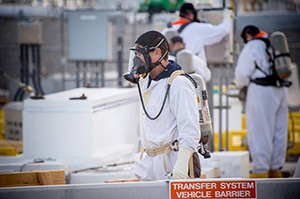Published February 1, 2017 at Teamster.org
Bill Would Help Ill Hanford Workers Get Compensation
By Annette Cary

Hanford workers would receive the same protections as firefighters in Washington if they developed serious illnesses, under a bill submitted Thursday for consideration by the state Legislature.
The extra protection is needed because of a lack of real-time monitoring and data for chemical vapors at the Hanford tank farms, said Nick Bumpaous, vice president of the Central Washington Building Trades.
Workers who become seriously ill after exposure to chemical vapors have trouble providing the proof needed to get a workers’ compensation claim accepted, he said.
Penser North America administers the Hanford workers’ compensation program, and the Washington State Department of Labor and Industries allows or denies claims.
“My entire concern is supporting worker safety,” said Rep. Larry Haler, R-Wash., lead sponsor of the House bill and a past Hanford worker for 40 years.
He sees the bill as a step toward getting to the bottom of resolving the safety issue.
Three more Hanford workers reported suspicious smells that could be from chemical vapors Thursday afternoon at Hanford. Nine workers reported suspicious odors the day before outside a Hanford tank farm.
Workers are concerned that exposure to the chemicals could lead to serious health issues, including neurological and respiratory diseases.
The bill would require the workers’ compensation program to presume that a wide range of diseases were caused by occupational exposure.
The federal Department of Energy would be liable for those claims and state funds could not be used for any of the costs of the claims, according to the bill.
Workers would be required to work at a minimum one eight-hour shift at Hanford to be eligible for the added protection.
Covered diseases include respiratory disease, neurological disease and a wide range of cancers, including leukemia and lung, thyroid, brain and colon cancer.
Heart problems also would be covered if they were experienced within 72 hours of exposure to chemical vapors or other toxic substances at the nuclear reservation.
The state Legislature passed a similar bill for firefighters in 1987.
Some of the covered diseases are similar. But the law requires the presumption that firefighter illnesses were caused by occupational exposure to be balanced with evidence such as a firefighters’ history of smoking, physical fitness, lifestyle, hereditary factors and other known exposures.
The requirement that other factors be considered was not included in the bill addressing Hanford worker health. Hanford workers are at a higher risk of contracting serious diseases — such as chemically induced dementia and thyroid cancer — from exposures to chemicals at Hanford than they are of contracting the illnesses through lifestyle choices, Bumpaous said.
“These are working class folks who do not have law firms behind them,” he said.
Some Hanford workers are losing everything they have, including their lives, because of workplace exposures, he said.
Ill workers, who are not earning a paycheck and no longer have medical coverage, may face foreclosure on their homes and bankruptcy. The burden of their care may fall to state taxpayers when the burden should be put back on DOE, he said.
“I want to make sure workers are safe and they are taken care of if there are injuries,” Haler said.
The bill is likely to have some amendments if it gains a committee hearing and moves forward through the legislative process, he said. Five other state representatives, all Democrats, have also signed onto the bill.
The workers’ compensation program is a long-standing area of frequent employee concern and contention, said the National Institute of Occupational Safety and Health after reviewing chemical vapor issues at Hanford last year.
“Workers feel the system is onerous, with an extensive burden on the worker to demonstrate work-relatedness of health conditions,” the NIOSH report said. NIOSH is the part of the U.S. Centers for Disease Control and Prevention focusing on worker health and safety.
“(They) are frustrated when work-relatedness is disputed by the insurer because of insufficient proof of exposure or because a particular health effect cannot be sufficiently attributed to work,” the report said.
Last year, more than 60 workers received medical checks at Hanford because of possible exposure to chemical vapors related to waste stored in underground tanks. Most were released by the Hanford occupational medical provider to return to work the same day.
The three workers who smelled suspicious odors Thursday morning all declined medical evaluations, as did the nine workers who detected an odor Wednesday.
Supplied air respirators are required inside the fence lines of Hanford tank farms where waste is stored, but both incidents this week were outside any tank farms.
On Thursday, workers were performing calibrations on a continuous air monitoring system used for the AZ Tank Farm, but located outside it. They opened the sample system cabinet and reported smell variously reported as burning electrical, musty and an ammonia odor.
On Wednesday, workers were near work trailers about 200 yards outside the AP Farm fence line for pre-job briefings and reported smells similar to rotten eggs, sulfur or onions.
In both incidents, workers were told to leave the area and access was restricted until analyses of air samples showed air was safe to breathe.
DOE has invested $50 million in the past two years to increase worker protection from chemical vapors and is working on more improvements costing an additional $65 million.
http://www.tri-cityherald.com/news/local/hanford/article129070204.html